The Roman helmet and the gladiator helmet have long been a subject of fascination and intrigue. Furthermore, these ancient headpieces hold a wealth of historical and cultural significance, showcasing the advanced craftsmanship of the Roman Empire.
In this comprehensive article, we will explore each Roman helmet, the depicted meaning behind their style and design, the history and significance of these iconic headgear worn in battle, and their relevance in the modern day.
You will occasionally notice slight similarities between each style throughout the periods. In fact, you may even recognize similarities between some of these and the versions from the Greeks.
The Roman Helmet
The Romans produced a wide range of helm styles, each with its unique design and purpose.
Some unique characteristics of ancient Roman headgear are embossed eyebrows, cheek plates, horse hair, plumes, and more. Here are some of the most notable types and ranges of the Roman helmet:
Coolus Helmet
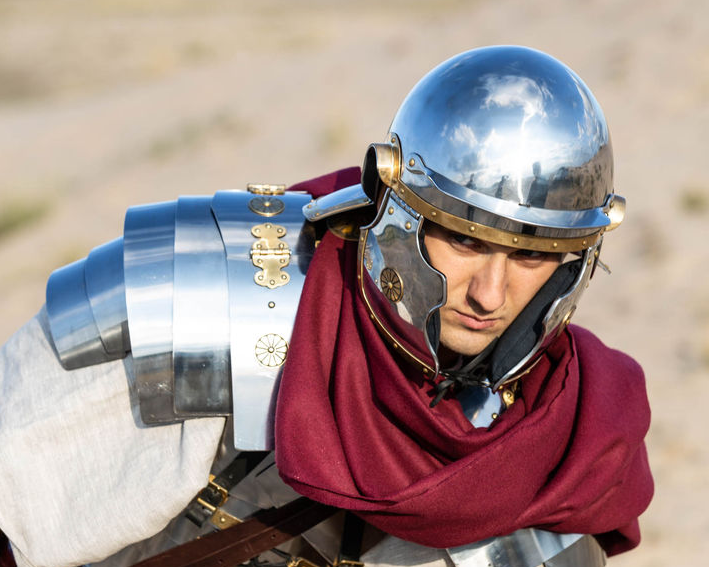
First, the Coolus helmet, derived from Gaulish origins, was one of the earliest helmet styles used by the Roman Army.
It featured a simple, rounded shape with cheek guards to protect the face. Evidence shows this type of helmet was mainly made of bronze, providing sufficient protection to the head.
Imperial Gallic Helmet
Introduced during the 1st century BC, the Imperial Gallic helmet was widely used by Roman soldiers. It featured a streamlined design with a distinctive crest running from front to back.
The cheek guards were more pronounced in this helmet, offering enhanced protection. These historical headpieces were typically made from iron or bronze.
Italic Helmets

Next up, Italic helmets refer to a broad category encompassing various regional designs. A conical or hemispherical shape characterized these headpieces, often featuring intricate decoration and engravings.
The Montefortino helmet, a subcategory of Italic headgear, was widely used from the 4th century BC to the 1st century AD.
Intercisa Helmet
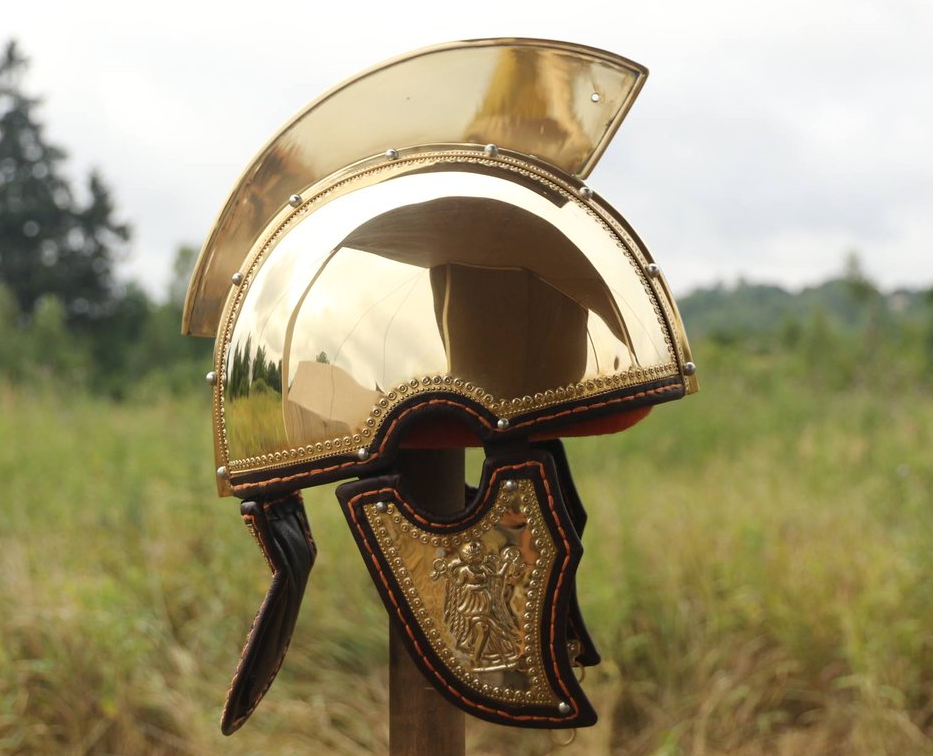
This type of helmet derived its name from the location of its discovery, Intercisa (modern-day Dunaújváros, Hungary).
The Intercisa helmet featured a unique face mask that covered the entire face, leaving openings for the eyes and mouth. It was crafted from iron or other metals and designed with intricate detailing.
Imperial Gallic G Helmets
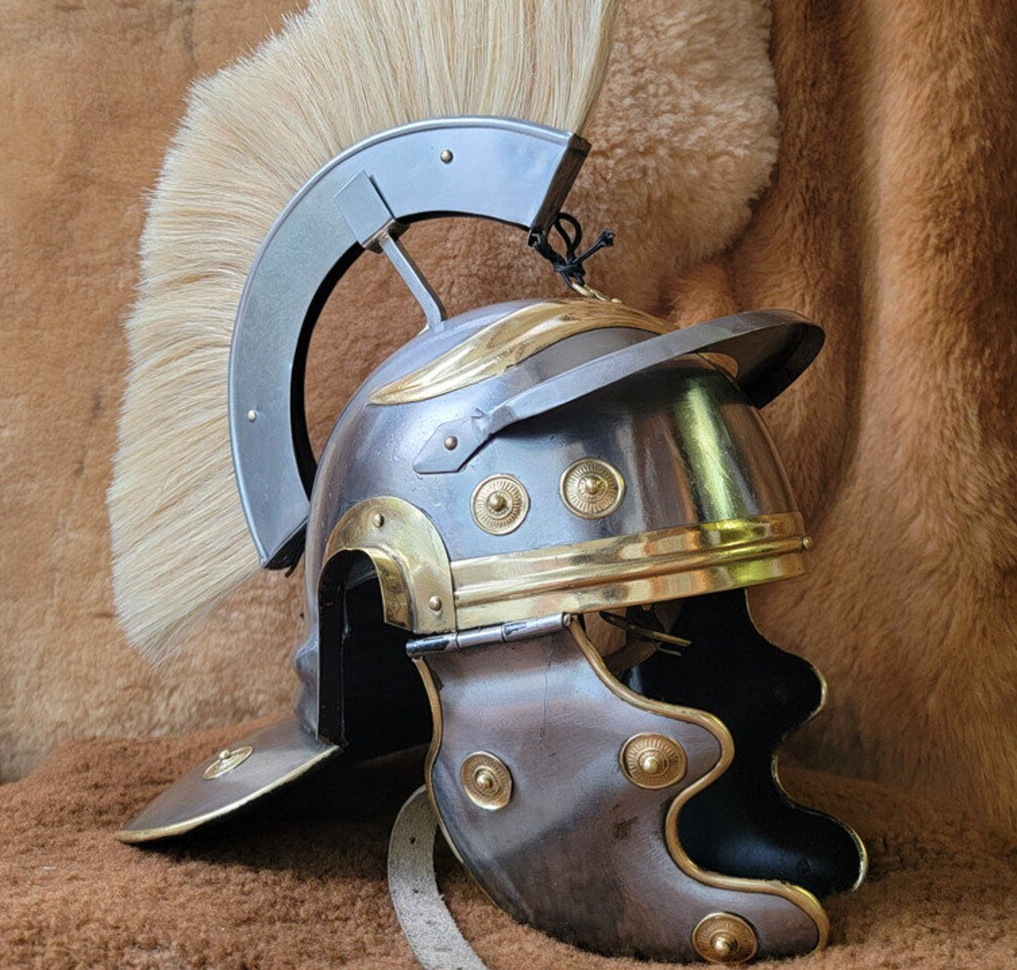
The Imperial Gallic G helmet was an updated version of the Gallic helmet, incorporating improved protection for the face and neck.
This helmet featured a broad brim, a pointy top, and impressive cheek guards with decorative patterns and was predominantly made from iron.
Ridge Helmets
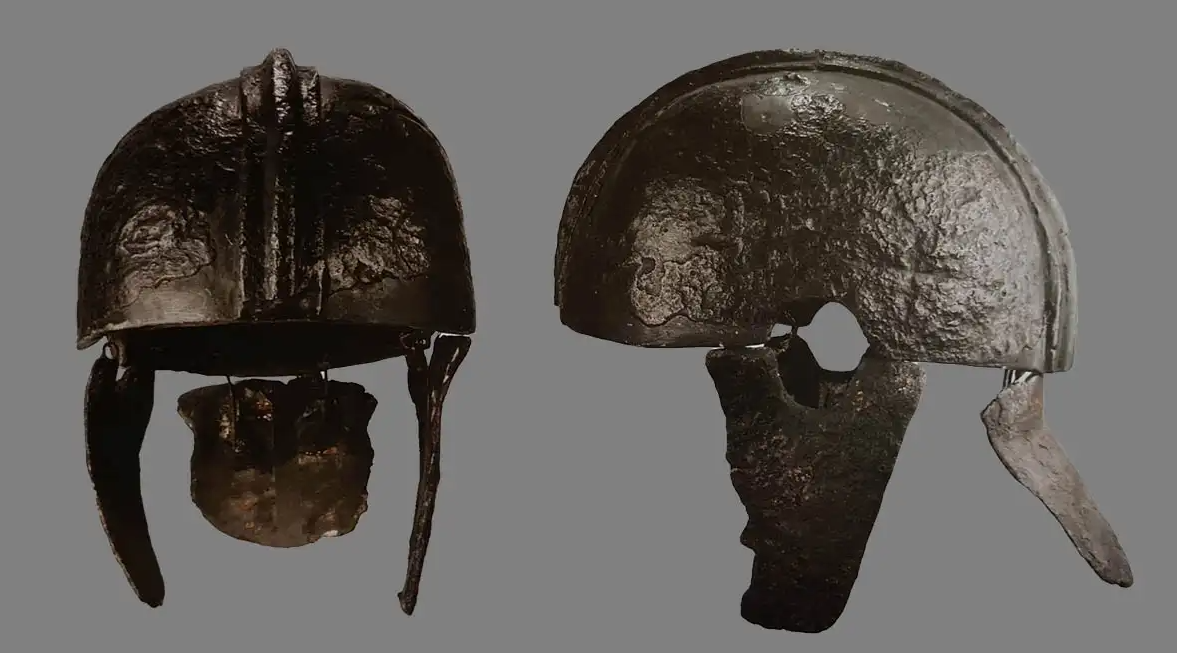
As the name suggests, ridge helmets are characterized by a ridge running from the front to the back of the helmet. These pieces featured a semi-circular structure and were commonly made of iron.
The ridge strengthened the helmet when worn and reinforced attacks from above. This was vital for legionaries and centurions, as missing this protection could be a death sentence.
The Gladiator Helmet
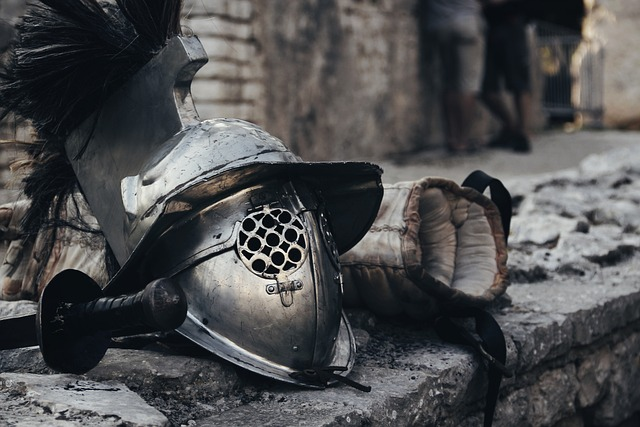
The Gladiator helmet, also known as the gladiatorial helmet, holds a special place in Roman times. They were specifically designed for those who entertained audiences during battle with their combat skills in the ancient Roman arenas.
Each gladiator helmet was tailored to suit the gladiator’s specific needs and fighting style. Here are a few notable gladiator helmet types:
Retiarius Helmet
The Retiarius gladiators were known for using a trident and a cast net. Their helmet design prioritized visibility and agility if they wore head protection whatsoever.
The retiarius helmet typically featured a round, open-faced design, allowing the gladiator a wider vision field and better maneuverability.
Secutor Helmet

First, Secutors were heavily armored gladiators who specialized in close combat. Their headgear had a distinct, elongated structure and a rounded top with a small eye-opening. These headpieces featured a visor, protecting the face without obstructing the gladiator’s vision.
Murmillo Helmet
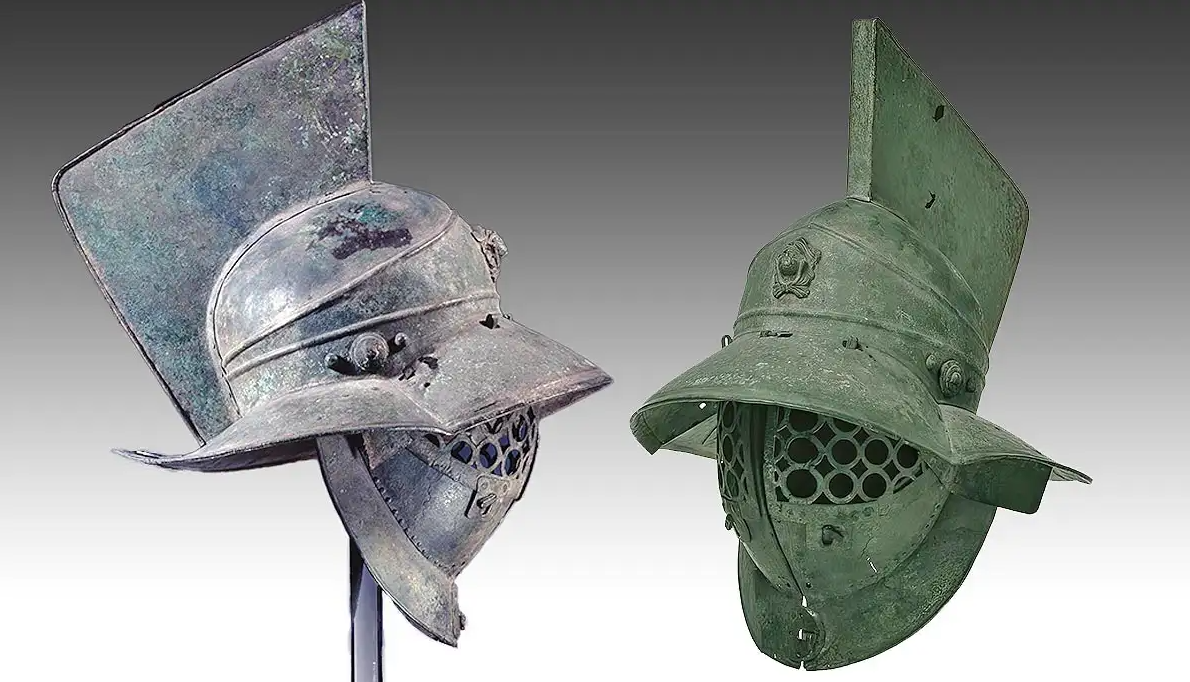
The Murmillo helmet was designed for the Murmillo gladiators, known for their aggressive fighting style.
Also, this headpiece had a large, rounded top with a wide brim and a visor that covered the entire face. The visor typically had small openings for better visibility and ventilation.
Thraex Helmet

Last (but not least), Thraex gladiators were inspired by Thracian warriors and fought with a curved sword and a small rectangular shield.
Their historical helmets originally had a specific design, with a wide, flat brim that extended forward, resembling a bird’s beak. So, this design provided extra protection to the face and neck.
Meaning and Symbolism of a Roman Helmet
Each Roman headpiece held significant meaning and symbolism in ancient Roman society centuries ago. They were protective gear and symbolized the wearer’s status, rank, and professionalism.
The design and craftsmanship of these headgear were a testament to the Romans’ advanced military technology and skill.
The crest, a common feature of worn Roman armor, was crucial in distinguishing different ranks and units.
The crests were often made from horsehair and were dyed in various colors, serving as an identifying marker on the battlefield.
In fact, the headgear design could signify the wearer’s cultural and regional origins. Helmets from different regions had unique characteristics and decorations, showcasing the diversity within the empire.
History and Significance of the Roman Helmet
The use of these historical helmets in ancient Rome dates back to the early Republican period. Initially, the Roman headpiece was heavily influenced by Etruscan and Greek designs.
However, as the empire expanded and encountered various cultures and warfare tactics, the headpiece designs evolved to meet new challenges.
Undoubtedly, the primary purpose of each Roman headgear was to protect the soldiers’ heads from blunt force impact, projectiles, and slashing attacks.
Using metal, such as bronze and iron, allowed for increased durability and protection. The helmets were often reinforced with cheek guards, face masks, and neck guards to shield vital areas.
Additionally, these helmets played a crucial role in the success of Roman military campaigns. They provided physical protection and instilled confidence and professionalism among the soldiers, along with their Roman armor.
The distinctive appearance of the helmets helped create a formidable and unified image for the armies of the Roman Empire.
Furthermore, each Roman helmet reflected the social hierarchy within the military. The design, materials used, and decorative elements varied based on the rank and position of the wearer.
Higher-ranking officers and influential commanders often had more elaborate and intricately designed helmets, showcasing their authority and status.
Roman Helmet in the Modern Perspective
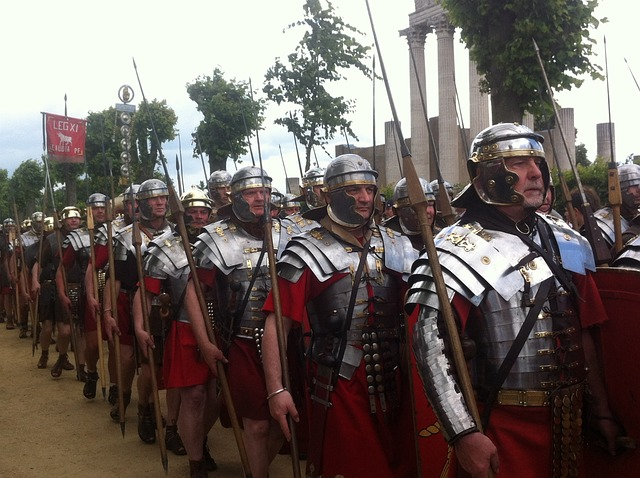
In the modern day, ancient Roman helmets and gladiator helmets continue to captivate the imagination of people worldwide.
They have become iconic symbols of ancient Rome and are often featured in movies, TV shows, and historical reenactments.
Museums and historical sites dedicated to the Roman era showcase a wide array of well-preserved helmets, providing visitors with a tangible connection to the past.
These helmets’ intricate craftsmanship and design serve as a testament to the ingenuity and skill of ancient Roman artisans.
Collectors and enthusiasts are also drawn to Roman helmets, seeking to acquire these historical artifacts as part of their collections. The rarity and historical significance of Roman helmets make them highly sought after.
Additionally, the symbolism of ancient Roman helmets continues to resonate in various aspects of modern culture. The crest design, for example, has been adopted by sports teams and organizations as a symbol of strength, determination, and unity.
It serves as a reminder of the resilience and leadership, often centurions, demonstrated by the Romans.
Conclusion: The Roman Helmet
In summary, Roman and gladiator helmets represent a remarkable chapter in ancient Roman history. However, not many people know there is such variety throughout their reign.
So, the variety of protective headgear designs, symbolism, and the advanced craftsmanship showcased in their construction have contributed to their enduring significance.
From the earliest Coolus headgear to the elaborate gladiator helmets, these headpieces were vital protective gear and armor for Roman soldiers and gladiators alike.
The meaning behind the design of Roman headgear reflects the cultural diversity and social hierarchy within the Roman Empire. The crests, materials used, and decorative elements conveyed the wearers’ stature, origin, and professionalism.
These ancient hardhats were not merely functional but also held symbolic value, instilling a sense of pride and unity among the soldiers.
Throughout history, ancient Roman helmets have played a significant role in the success of Roman military campaigns. They provided essential protection against various forms of attack, keeping soldiers safe on the battlefield.
The craftsmanship and durability of these headgear were a testament to the advanced military technology of the Romans.
In the modern day, Roman helmets continue to captivate our fascination with ancient Rome. Museums display these artifacts, allowing us to appreciate the skill and artistry of Roman craftsmen.
Today, collectors and enthusiasts seek these headpieces as unique historical pieces, preserving their significance for future generations.
Roman Helmet: The Bottom Line
The influence of Roman helmets can also be seen in the modern world, with their design elements incorporated into various aspects of culture, sports, and symbolism.
For this reason, they continue to inspire and serve as a reminder of the power and legacy of the Romans.
In conclusion, Roman and gladiator helmets hold immense historical, cultural, and symbolic significance. From their diverse designs to their role in the Roman military, these headpieces have impacted our understanding of ancient Rome.
Finally, their craftsmanship, meaning, and historical importance continue to captivate and inspire us today.
Image credit: The Collector
Also, if you enjoyed this article, check out this one about the Emerald Tablets next!

